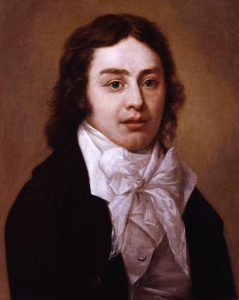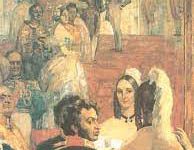The Love of S T Coleridge
The Love of S T Coleridge
If one cannot be happy with his wife in the matter of love, he can never be happy with any other woman. So was the case of Samuel Taylor Coleridge, an English poet, and critic of the first half of the 19th century. He, with William Wordsworth, inaugurated the Romantic Movement in English Literature with success. He had fallen in love with several women but he could not be happy with anyone. Instead, they increased his unhappiness and disappointment in life.
S T Coleridge was born in 1772 in Devonshire. His father John Coleridge was a learned schoolmaster but unworldly in matters of real life. On the other hand, his mother was more active and took great care in bringing up her children. Coleridge seemed more imaginative from his childhood. He took a keen interest in reading old romance stories including The Arabian Nights.
After his father’s death in 1781, he was sent to school under his mother’s guidance. In school, he seemed to be more introspective and he liked reading eagerly than giving attention to frolics and to the school curriculum. During this school life, he read Homer, Virgil, Shakespeare and the Greek Classics in translation voraciously. In school, he met Charles Lamb, who later on became a great essayist. He also met John Evans as his classmate with whose sister he fell in love. In 1791 he joined Jesus College, Cambridge. Here he showed interest in propagating Republicanism and reviling in wine parties. On the other hand, his passion for Marry Evans, the sister of his schoolmate John Evans began to grow deep but he could not develop his love affair with her. Thus his first love fell down with disappointment.
S T Coleridge was rebellious like P.B. Shelly towards social conventions during his student life. In 1794 he met Robert Southey, who became a poet later on, and together the two engaged themselves in an idealistic but impracticable plan called Pantisocracy with the aim of reforming the entire human race. They determined that they would take twelve gentlemen of good education and liberal principles and marry twelve ladies and migrate to somewhere in America and there they would form a classless society. But their plan withered in the bud as Coleridge and Southey could neither find willing participants nor an adequate amount of money. But as his initial enthusiasm for it, Coleridge married Sarah Fricker in a hurry. She was beautiful and smart but she was neither emotionally nor intellectually suitable to him. It was really a whimsical motive to get married in the interest of Pantisocracy and soon he realized his foolishness. He was still attached to Marry Evans and made a passionate appeal to her for marriage but she declined the offer except for giving sisterly affection. Then he wanted to divorce Sarah, but his friend Charles Lamb prohibited him to do so. Coleridge, however, kept Lamb’s words and he had to repent for that haste marriage throughout his life. When a husband shows affection to another woman in addition to his legal wife then the passion for his own wife deteriorates. So was what happened to Coleridge. He never could receive Sarah Fricker with his whole heart. So there had always been a gap between the couple.
In 1796 he brought out the first collection of his verses under the title, Poems on Various Subjects. This collection was received well by the reader community. In December a child, Hartley Coleridge was born to them. In 1797 Coleridge met Wordsworth, the father of English Romanticism and since then they began to live together. They—Coleridge and Wordsworth—together, brought out a collection of poetry in 1798 under the title, The Lyrical Ballads and with the publication of it, the Romantic Movement in literature began. In the same year, Coleridge and Wordsworth went to Germany. When Coleridge went to Germany leaving his wife in Stowey, England then his wife Sarah Flicker got a chance to be near Southey. Between Sarah and Southey, little affection had developed. Coleridge, returning from Germany found quite a hostile and unfriendly Sarah. The gap between the two broadened.
The dejection fell down on his life. His health always had been unsteady. He was persistently scourged with rheumatism and spasm in the stomach. After someone’s suggestion, he began to take in opium as an anodyne. Already his relationship with his wife became worse. The quarrel between the two ran on. Already his health began to disturb his mentality. His addiction to opium became irremediable. He developed unhealthy fatness and started looking prematurely old.
Already he had fallen in love with another woman by the name of Sara Hutchinson, who was the sister of Marry Hutchinson, the wife of his friend William Wordsworth. She was a young lady of great understanding and sympathy. Coleridge wished to marry her—but he saw no course to divorce his wife, hence the marriage could not happen. His love for Marry Hutchinson added to his misery and disappointment.
Amid that misery and dejection, he wrote his monumental work, Biographia Literaria in 1817. Then he went to London and stayed at Highgate. Here he took treatment from Dr. James Gillman. The doctor was very sympathetic to the poet and along with his wife, he gave Coleridge much-needed understanding and tried to develop their affection towards each other. For the remaining years of his life, he spent a life of suffering and pain of dejection. As a poet, he wrote on but he could not complete his masterpiece the Biographia Lieteraria.
In 1834, S T Coleridge died living a life of utter suffering and unrest. 0 0 0 S T Coleridge
S T Coleridge
N.B. The article ‘The Love of S T Coleridge’ originally belongs to the book ‘Love of Reputed Persons‘ by Menonim Menonimus.
S T Coleridge
Books of Composition by M. Menonimus:
- Advertisement Writing
- Amplification Writing
- Note Making
- Paragraph Writing
- Notice Writing
- Passage Comprehension
- The Art of Poster Writing
- The Art of Letter Writing
- Report Writing
- Story Writing
- Substance Writing
- School Essays Part-I
- School Essays Part-II
- School English Grammar Part-I
- School English Grammar Part-II..
Books of S. Story by M. Menonimus:
Related Search:
- 25 Best Love Quotes
- Greatest Real-Life Love Stories
- Psychology of Love
- Beautifully Written Love Stories
- The Secret Lives of Writers











